Anthony Metivier's Blog, page 23
December 11, 2019
Nir Eyal On Creating Indistractable Focus And Techno Panic-Free Focus
 Writer and philosopher Paul Virilio famously said “The invention of the ship was also the invention of the shipwreck.”
Writer and philosopher Paul Virilio famously said “The invention of the ship was also the invention of the shipwreck.”
In this day and age, how true, how fitting…
With every success comes unforeseen consequences.
Just look at Facebook.
Once touted as a revolutionary social networking giant, and undoubtedly the forerunner of modern digital communication, it is now more famous for its “scandals” in the 2016 US Presidential election and data breeches (i.e. selling your private data).
Do you think Mark Zuckerberg could ever have imagined this level of influence and power could be his when he dreamed up the platform in his dorm room? Or the consequences and downfall that comes with it?
And that’s just the “big stuff.” What about the role of tech and social media in our everyday lives?
Don’t we enjoy a rush of adrenaline or a bit of a dopamine spike when our device lights up and sounds that familiar ping, or we see our phone buzz on our desk?
We are, without a doubt, under a spell.
And it’s not just Facebook. I’m looking at you Instagram, YouTube, Pinterest, Snapchat, and Tiktok (and whatever the hot new app is coming down the pipeline next).
The notifications call.
We answer.
And just like the Titanic, we unwittingly are steering our ship towards an iceberg, all due to distraction.
But what if our lives weren’t ruled by the hefty priced device in our pocket?
Today I sit down with bestselling writer, Nir Eyal, author of Hooked: How to Build Habit-Forming Products and Indistractable: How to Control Your Attention and Choose Your Life.
Nir is a former Stanford Graduate School professor and accomplished and successful angel investor, consultant, and teacher. We discuss Indistractable and how you can break the cycle of “ding, glance (or in reality 30 minutes later), return to task/conversation/work/sleep, repeat.”
You don’t have to live as a slave to technology. You are not a slave of your own making. You are the captain of your ship.
Curious and want to know more? All you have to do is press play (above) now and you’ll discover:
Why “indistractable” is a noun, and not an adjective
How a moniker can set you up for success
The reason we can look to religion as an example of healthy habits…even if we’re “nonbelievers”
The benefit of teaching to form one’s own identity
The tactful way you can encourage those around you to be indistractable
How we define social antibodies, and how they can help culture, as a whole
Why we should lead by example where technology dependence is concerned… but, at the same time, need to push back on the techno panics (I agree to large extent with Nir on this point, but still feel Digital Amnesia is a pressing issue and we’re too early in the game to say much either way)
Where blame really lies for technology addiction (and it’s not what you think)
Why detoxes, “30 day plans,” and other extremist responses aren’t the solution to calm a distracted mind and life
The reason distraction doesn’t always look like what we think (it’s not all Instagram and Candy Crush folks!)
The real cause of our distraction and the greatest source of distraction (hint: it’s not an outside source and Evernote is probably okay to use)
Why a five year plan approach isn’t the most effective measure of your values…and what is
The three key areas to consider when dividing and prioritizing your time
Do I Recommend Indistractable?
As a matter of fact, I do.
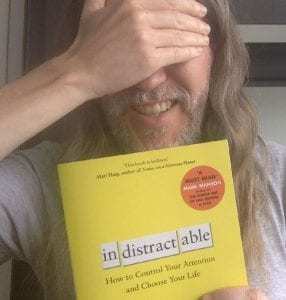
Even though I’m goofing around in this photo, the fact is that without the techniques Nir shares, I’d be a nutcase. I’d never be able to keep up the pace of a nearly-weekly podcast with YouTube videos, blog posts and new memory training products if I couldn’t make myself indistractable.
I learned new concepts from this book and, very importantly, reinforced old ones.
Even if you think you’ve heard it all before, I promise you this book will give you some surprises, compelling new research findings and unexpected help. To wit, you even get a precious analog device that could be worth millions to you one day. (No exaggeration.)
And if you are that rare cat who really has heard it all before, then you already know the wisdom of reinforcement. You have already used the speed of implementation rule to order your copy. Congrats!
In case you don’t know that rule, watch this:
Further Resources on the Web, this podcast, and the MMM Blog:
Nir And Far (Nir’s official website)
Special link for ordering Indistractable
Nir’s article on habits vs. routines
Nir Eyal’s Morning Routine on Business Insider
Indistractable’s feature on Forbes.com
Timothy Moser Talks About Memory Skills and Productivity (MMM Podcast)
3 Shocking Ways Smartphone Addiction Erodes Your Brain and Memory
The post Nir Eyal On Creating Indistractable Focus And Techno Panic-Free Focus appeared first on Magnetic Memory Method - How to Memorize With A Memory Palace.
November 26, 2019
Memory Athlete Braden Adams On The Benefits Of Memory Competition
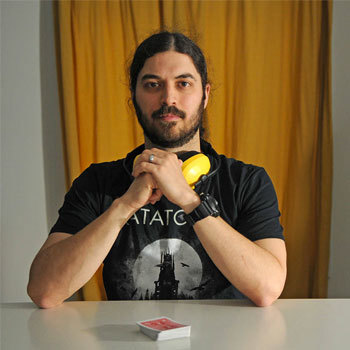 Memory competition is one way to train your brain and keep your mind sharp.
Memory competition is one way to train your brain and keep your mind sharp.
And who best to talk about how the benefits you can expect from joining a competition than one of the most disciplined students and trainees of memory?
My guest today is fellow Canadian Braden Adams from Chilliwack, BC.
Braden is the cofounder and board member of the Canadian Mind Sports Association on top of being an accomplished memory athlete himself.
He is a three time BC Memory Champion, 2018’s CMSA’s National Memory Champion and the 2018 IAM Canadian Memory Champion.
On this episode of the Magnetic Memory Method Podcast, he shares his personal memory journey, beginning purely by chance, and evolving into an absolute passion for mental athleticism.
Braden shares his tips and secrets to his success that just may have you interested in going toe to toe with one of the world’s premiere memory athletes.
Just press play now and you’ll learn all about:
The (perhaps unintended) introduction to memory techniques that (probably) 80 to 90 percent of memory athletes in the last decade share
Which book may be the most polarizing in the memory world
Why memory competitions aren’t as intimidating as you may think
How to prepare for “real life” memory challenges in environments that are less than ideal
The two-fold benefit to competing in memory sports
How memory techniques can help even those with a naturally good memory
Why memory training is not so different from drinking water or hitting the gym
The way to maximize your time to get the most out of memory exercise
How a beloved TV sitcom can help you to remember more than you thought possible
The reason magicians make great memory competitors (hint: it’s in an unassuming prop)
Why we cannot place limits on our memory
Further Resources on the Web, this podcast, and the MMM Blog:
Braden’s interview with CTV News
Braden’s The Star interview from 2018
“Memorable Victory” on CBC News
2019 Canadian Memory Champion Reveals His Memory Secrets (James Gerwing’s interview referenced in this podcast)
Ready to enter a competition? Read more about the Canadian Mind Sports Association’s 2019 National Memory Championship or check out Art of Memory’s current memory competitions list
The post Memory Athlete Braden Adams On The Benefits Of Memory Competition appeared first on Magnetic Memory Method - How to Memorize With A Memory Palace.
November 21, 2019
Focused Attention: 5 Fun Ways To Experience It And Boost Your Memory
 Focused attention is…look a squirrel!
Focused attention is…look a squirrel!
Aren’t they the cutest?
Gotta get to the laundry.
Now, wait a minute…where was I?
Right! I was writing about focused attention.
It is usually the squirrel’s fault, but often deliberate use of focused attention is needed to do the task at hand or to know what’s happening around you.
So what is focused attention?
In this post, I’ll explain all about it plus give you five magnetic ways to improve your concentration abilities.
Here’s what I’ll cover on this page:
What is Focused Attention?
A Few Risky Examples Of Focused Attention
Different Types of Attention
What Happens if Your Focused Attention is Damaged?
The Link Between Focused Attention and Stronger Memory
5 Ways to Strengthen Your Focused Attention (Once you have it)
What is Focused Attention?
Focused attention is the ability of your brain to concentrate on one activity for a specified period of time.
When you use focused attention, your brain allocates cognitive processing resources that allow you to choose and concentrate on one task at a time.
It is an essential skill that enables you to carry out different tasks in your daily lives with a high level of efficiency.
However, you need to understand that to pay attention to one stimulus or action, your brain, by default, ignores all other stimuli.
If every stimulus had to be perceived, we would go crazy.
For example, you are at a loud, crowded party, looking for your friend. You look for her blue sequined dress, and you concentrate on hearing her voice over the music. Your brain is continuously, moment by moment, ignoring the voices of other people to focus its attention on finding the voice of your friend.
And there she is! Calling out your name, which your mind was able to hear over the general uproar due to its use of focused attention.
A Few Risky Examples of Focused Attention
Imagine watching TV while cooking.
You are doing two things, but if your focus wanders away from the pot, you may burn your sauce or over boil the pasta.
On the other hand, when you are concentrating on cooking, you may miss the next Kardashian scandal.
In effect:
Your brain uses focused attention to do one task at a time.
If you try to multitask, your performance levels would be low for each task. For instance, it is not possible to try to study while watching TV and retaining the information presented by the book as well as the TV show accurately.

Hanging out in a coffee shop after an intense learning session in Brisbane
However, there is something called selective attention that you use when working from a noisy environment like a coffee shop.
How does that work?
A coffee shop is not a quiet place. There are customers ordering lattes, people exchanging gossip or speaking loudly on the phone. However, these levels of background noise are low enough for the mind to concentrate on the work at hand.
You use focused attention every single day, from when you clean up the table after dinner to when you pick up something that fell off the desk.
Before we move on, let’s take a brief deep dive into other types of attention.
What Are the Different Types of Attention?
The American philosopher and psychologist William James defines attention as “the taking possession by the mind, in clear and vivid form, of one out of what seem several simultaneously possible objects or trains of thought. Focalization, concentration, of consciousness are of its essence. It implies withdrawal from some things in order to deal effectively with others…” (The Principles of Psychology, 1890).
Attention is not a simple process. It is the beginning of other cognitive functions. You need to pay attention before you can comprehend something.
The Sohlberg and Mateer Hierarchical Model breaks attention into five sub-components.
The model was initially used to test the recovery and development of attentional function in long-term coma patients (after they were awake, of course). However, it was soon found to be useful in determining attentional skills in other people – including students, making this a popular model for the study of “attention”.
The sub-components of the Sohlberg and Mateer Hierarchical Model are:
Focalized (Focused) Attention: This refers to your ability to focus attention on one stimulus. For example, when you are writing an exam and need to concentrate entirely on your answers.
Sustained Attention: This is your ability to attend to an activity or stimulus over prolonged periods of time. For instance, when you are playing a video game.
Selective Attention: This refers to your ability to focus on a specific stimulus in the presence of other distracting stimuli. For example, in a classroom, this would be a student’s ability to maintain focus on the lesson while his peers chatter or pass notes.
Alternating Attention: Commonly known as multitasking. This is your ability to change focus attention between stimuli that need different cognitive functions. For example, reading a recipe while preparing a meal.
Divided Attention: This refers to your brain’s ability to attend to different stimuli at the same time. For example, when you are driving a car while talking to a passenger.

Even thinking and listening at the same time can divide our attention.
As the cognitive science of attention evolved, it emerged that your ability to pay attention depends on various factors:
It is easier to process a task correctly when you’re motivated and alert than sad or tired, or if the stimulus is monotonous. Anxiety also affects your ability to focus on a job.
If a task is complex, your brain finds it more difficult to sustain focused attention on that particular task. It can get distracted easily.
Your brain takes less effort to complete a routine task, but if the work is new or unfamiliar more effort is required.
Your cognitive abilities are affected by your levels of mindfulness when doing a task.
Knowledge of the cognitive science of attention improves our learning of the nuances that affect “attention”. It enables us to understand what processes are needed to function efficiently in our everyday environments and how to eliminate distractions that damage our attention capacities.
What Happens if Your Focused Attention is Damaged?
Getting distracted is common.
And losing focus or awareness of your surroundings when you are distracted is also usual.
However, if you get easily distracted or have trouble paying attention when conducting everyday tasks like reading a book, listening, writing, or even watching TV, it may be cause for concern.
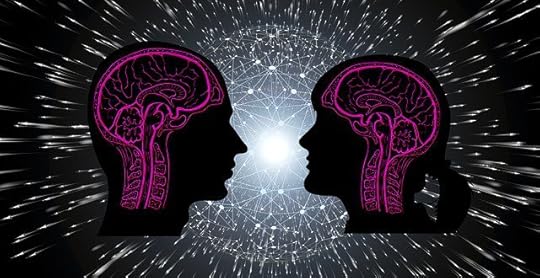
Your focused attention can get damaged due to disease, disorder, or damage to some parts of the brain.
Hemispatial neglect or heminegligence is a common disorder that can cause loss of focused attention. Hemispatial neglect is a neuropsychological condition caused by damage to one hemisphere of the brain due to stroke or injury.
ADD Vs. ADHD And How They Degrade Attention
Another known disorder is Attention Deficit Disorder (ADD) or Attention Deficit Hyperactivity Disorder (ADHD), which majorly affects the attention of the individual, making it difficult for them to detect the target stimuli.
Usually, a continuous performance test (CPT) detects Attention Deficit Hyperactive Disorder (ADHD). However, researchers are now conducting studies to validate the usefulness of a continuous performance test in diagnosing ADHD in children.
Some kids with autism spectrum disorders (including Asperger’s syndrome) also show symptoms which are similar to learning and attention disorders. However, these two conditions are different and need different treatment.
Other disorders that affect focused attention include dementia, Alzheimer’s disease, and schizophrenia. But the good news is that memory training helps, such as one of students found when suffering yet another issue: PTSD.
The Link Between Focused Attention and Stronger Memory
Have you ever noticed how, when something is interesting, your focused attention is absolute?
For example, you can focus better when watching the World Cup as opposed to when you have to compile the 10-page sales report.
However, if your boss is waiting for the 10-page sales report, you would work on it despite all distractions to get it ready on time.

So you see, your attention span or focus can change depending on whether the stimulus is exciting (football match) or if the stakes are high (work deadline).
Which also brings to focus the fact that you can train yourself to do everyday tasks with a higher level of focused attention.
And as we all know…
Concentration or focus is the key to better memory recall.
Focused attention is essential to well-formed memories and useful recall of information. A lack of attention, on the other hand, leads to difficulty remembering crucial pieces of information.
By becoming more deliberate and paying attention to the task at hand, you can do it with far more efficiency.
What’s even better?
Everything you do to improve your focus will also improve your memory and awareness of your environment.
How can you improve your focused attention?
5 Ways to Strengthen Your Focused Attention
Focus is to memory, what a key is to a lock.
While you can force a lock, if you don’t have the key, it is always easier to open the door with the right set of keys.
By making a few simple changes in the way you work, you can dramatically improve your levels of focus and thereby your ability to remember information fast.
Here are five ways you can strengthen your focused attention:
1. Create Memory Palaces Regularly
Creating Memory Palaces using the Magnetic Memory Method way can quickly improve your attention span.
The Magnetic Memory Method Memory Palace approach teaches you how to pay focused attention when you come across new information.
When combined with Magnetic Recall Rehearsal, this holistic process lets you move information from your working memory into your long-term memory faster and with better permanence.
Memory Palaces also enhance your mindfulness and awareness, which are essential in improving focus.
This video gives you some great hacks to extend your attention span quickly.
2. Meditate
Meditation has been practiced for thousands of years to improve focus and concentration.
It is a powerful and scientifically proven method.
What’s more?
Meditation can be practiced anywhere without the need for fancy equipment or extensive training.

Walking meditation works too!
Moreover, you don’t need to meditate for many months before you can start noticing the benefits of your practice. Within a week of consistent mindfulness meditation, you can experience improved concentration.
Need more motivation?
Meditation doesn’t just improve focused attention. It also improves your memory, including semantic memory. I memorize lots of Sanskrit in my personal practice to help ensure that.
In an age of endless distractions and heightened stress, incorporating meditation to improve concentration, eliminate emotional problems, and refocus your mind is crucial.
Meditation has two categories – focused attention meditation and open monitoring meditation.
During focused attention meditation, you pay attention to a single object like a mantra, a candle, or your breathing.
When you practice open monitoring meditation, your attention is open. You remain aware of everything that is happening, including your thoughts, feelings, emotions, sounds, and bodily sensations.
Here’s a simple, step-by-step guide you can use every day to meditate.
Choose a time. Morning, noon, evening, it doesn’t matter.
Select a place to meditate. It could be your backyard garden or bedroom floor.
Set a timer (This is optional). Initially, set the timer for five minutes and when it rings, turn it off and then sit a little longer.
Sit and do nothing else. Focus on a specific emotion or general thoughts and feelings. You can even concentrate on your breathing.
When you finally arrive, enjoy, and observe.
Practice this simple form of mindfulness meditation for just five minutes a day, four times a week, and you’ll see improvements in many aspects of your life, including memory and focus.
Check out The Five-Fold Path To Memory Improvement, if you are keen on a more advanced approach to meditation (the one I use most often).
3. Exercise
Working out is an excellent way to improve focus.
Apart from improving your happiness quotient and keeping you fit, regular exercise can boost your levels of attention and concentration.
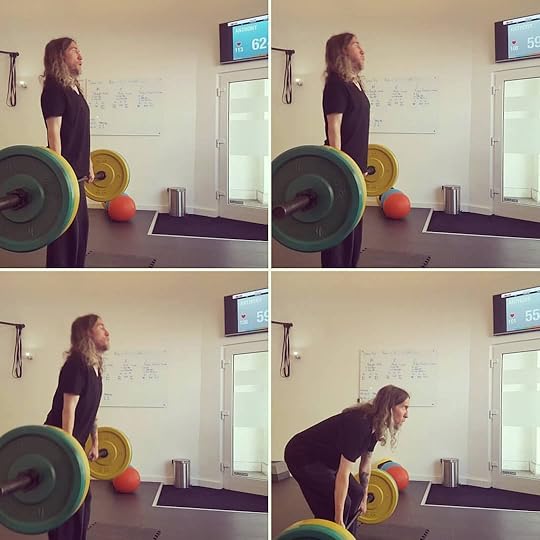
Deadlifting helps improve my focused attention and memory. Do you go to the gym?
One study observed that the attention spans of Dutch school pupils improved when 20-minute bouts of aerobics-style exercise interspersed their lessons.
In another study, a large randomized controlled trial in the US looked at the effects of daily after-school sports activities on the fitness levels of children. Predictably, the study found that the students got healthier.
What was more interesting was that the students also became more adept at ignoring distractions and multitasking.
The takeaway:
If you’re still thinking about going for a run, get on with it. Take action now to improve your focus and memory.
4. Rest
Resting to improve focus may seem a bit odd.
But it’s true.
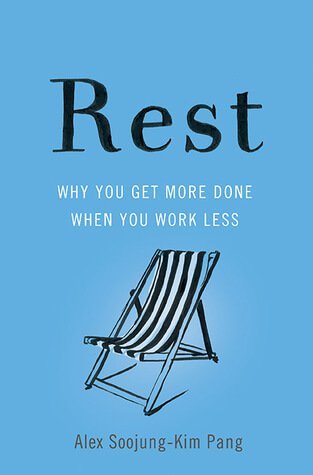
Silicon Valley futurist Alex Soojung-Kim Pang in his book Rest: Why You Get More Done When You Work Less, says successful people throughout history who displayed high levels of focus and concentration took a lot of “deliberate rest”.
From Charles Darwin to Ernest Hemingway to Stephen King, every one of these creative and highly accomplished people took “brain breaks” for extended periods of time to relax and rejuvenate.
When our brain is in resting mode, it switches to the highly active Default Mode Network (DMN). When you focus attention on the outside world, you suppress this default mode of neural processing.
These brain breaks allow you to update information and gain access to deeper aspects of yourselves, thereby enhancing your resilience, creativity, and decision-making capabilities.
Once you are back from your rest, you can focus better on the tasks at hand.
5. Practice Single-tasking
Focusing on one task at a time is your brain’s natural way of doing things.
When you avoid multitasking, you make fewer errors. Fewer errors also mean less stress, and that can enable you to concentrate better.
Single-tasking also helps to stabilize your mood and improve your memory since you pay more attention to one singular activity.
Give Tasks the Attention They Need
When driving, focus on the road. When eating breakfast, focus on your cereal or avocado-toast. When writing a report, focus on the specific task, and you’ll see how fast and efficiently you’ll get it done.
Giving each task the attention it needs improves your overall efficiency while enabling your mind to transfer information into your working memory.
Deliberate attention, in turn, improves retention and recall.
Need more ways to improve memory?
Why not get started with the Magnetic Memory Method Masterclass?
The post Focused Attention: 5 Fun Ways To Experience It And Boost Your Memory appeared first on Magnetic Memory Method - How to Memorize With A Memory Palace.
November 13, 2019
Lev Goldentouch On The Ultimate Key To Study Results Without Strain
 How many books have you read this year?
How many books have you read this year?
What about time spent reading news articles, magazines, or journals?
The numbers are shockingly low.
24 percent of adults surveyed hadn’t even read part of a book last year.
Even more surprising, in 2017, people in the U.S. over age 15 only spent, on average, 16.8 minutes a day reading for pleasure, or not required for work or school.
It seems a bit surreal doesn’t it?
Before television, radio, and, most recently, the smartphone, reading was one’s primary source of both entertainment and a source of news.
If you wanted to stay up to date on current events you picked up a newspaper. If you were looking for a way to escape the day to day humdrum of life you picked up you searched out your favorite author’s newest work of fiction.
It’s astounding to me that reading as a whole has declined so much. It’s no secret that reading is a great method of mental stimulation, stress reducer, and obvious knowledge booster and vocabulary expander.
The benefits to reading expand far beyond these named few and even boast a benefit that may surprise you…the simple act of reading can improve your memory.
Well, don’t fret. Because…
Lev Goldentouch Has The “Key To Study” That Helps People Read More… Faster!
My guest today is Lev Goldentouch.
He is an author, machine learning and information expert, as well as a lifehacker and technology guru. Through his blog, Key to Study, Lev teaches eager students his methods for improving their reading speed, retention, and therefore, their memory.
I know his skills in a more personal way too. We even share a cafe Memory Palace!

Dr. Lev Goldentouch and Dr. Anthony Metivier in Tel Aviv
So here’s why this interview is so important for you to hear:
If you want to remember more of what you read with less effort…
If you’ve tried other methods to improve your memory, relying too much on apps programs, and are looking for a change…
If you have a desire to transform your life by picking up a good book…
You’ve come to the right place. This podcast is a real page turner.
It’s as simple as clicking the play button above to discover:
The difference between a memory expert, a speed reading expert, and a machine learning expert
The overlooked way that people can forget things they would have liked to have remembered (Note: developing some dual-handedness skills can help too)
How to compare and contrast the different kinds of reading
Why actually having an interest in a subject is an important prerequisite to reading
The secret to becoming both more creative and spontaneous (it may surprise you)
How visualization is a universal tool, even for those blind since birth
Why your goals should meet certain criteria in order for you to be able to achieve them
The reason to copy a teacher and not a god or fictional character
The power of dancing to improve your memory
How it is possible to shape your future and to overcome bad fortune
What style of teaching makes a teacher the most effective
I hope you enjoy this episode of the Magnetic Memory Method Podcast and please consider investing in Lev’s complete training course. If you struggle with getting through learning materials, here’s how to complete a memory course rapidly.
Further Resources on the Web, this podcast, and the MMM Blog:
Lev Goldentouch’s Key to Study Premium Training Course
The Simple Reading Technique That Prepares Your Memory For Anything (MMM Blog)
How to Study Fast: A Guide to High-Volume Learning At Speed
11 Reasons You Should Re-read At Least One Book Every Month
The post Lev Goldentouch On The Ultimate Key To Study Results Without Strain appeared first on Magnetic Memory Method - How to Memorize With A Memory Palace.
November 6, 2019
The Mandela Effect: Is Your Memory Playing Tricks on You?
 Have you ever seen or heard something that felt… just a little off?
Have you ever seen or heard something that felt… just a little off?
Maybe you’re fairly certain you remember an event one way, but when you do a Google search, the information you find doesn’t line up with your memory.
It can be frustrating, confusing, and can even make you wonder if you’re starting to lose your mind (or if you’ve stumbled on a government conspiracy).
Turns out, there’s a name for what you just experienced. It’s called the Mandela Effect, and it’s more common than you might have imagined.
But what is this phenomenon, and why is it called the Mandela Effect?
What Is the Mandela Effect?
The Mandela Effect is a strange occurrence where large groups of people remember an event that didn’t occur or something that never existed. The group usually recalls the exact same thing in the exact same way.
It’s named after Nelson Mandela and his supposed death in prison in the 1980s. In fact, this former South African president was released from prison in 1990 and lived until 2013.
Back in 2009, Fiona Broome launched a website dedicated to the exploration of the Mandela Effect. She wanted to explore and document “memories that didn’t match our current reality and its history.”
Since that time, the Mandela Effect has continued to capture our collective attention. Fun fact: the subject was even broached by the writers of The X-Files (the recent reboot).
Now that you know a little more about what the effect is, let’s look at three of the most famous examples.
Mandela Effect Examples You Might Recognize
What types of events and products could cause mass mis-remembering? Here are a few times where memories don’t match the facts.
Nelson Mandela died in prison in the 1980s
The phenomenon that started it all…
Nelson Mandela was a South African anti-apartheid political leader who served as President of South Africa from 1994 to 1999. Before he was elected, he served a total of 27 (non-consecutive) years in prison for various political crimes against the state.
While he did suffer from tuberculosis in the late 1980s, he did not die. In fact, he was released from prison in 1990, and went on to be elected President just over 4 years later.
I know these facts because… I went and bought the book. This is my copy of The Long Walk to Freedom, and I read it as part of walking my talk by using the critical thinking suggestions I’ll share with you below:

Reading is a great way to get acquainted with the facts.
The Berenstain Bears are a family affair
One of the most famous examples of the Mandela Effect are the Berenstein… err… Berenstain Bears.
If you Google “Berenstain Bears,” one of the first people also ask questions is: “why did they change the name of the Berenstain Bears?”
Since their original publication in 1962, these delightful treehouse-dwelling bears have been beloved by many. In the 1980s, the characters experienced an upswing in product licensing. This included an animated series, software and video games, museum exhibits, and even an off-Broadway musical.
So, despite a large number of parents and children remembering the “Berenstein Bears,” there’s more than enough evidence out there that the name was always “Berenstain.”

Obi Wan killed your father!
One of the most famous (and most repeated) misquotes comes from one of the greatest movie franchises in history.
In the dialogue between Luke Skywalker and Darth Vader in 1980’s Star Wars Episode V: The Empire Strikes Back, Vader does not say “Luke, I am your father.”
Despite what the widely repeated and meme-d quote would have you believe, Darth Vader’s revelation has one single word changed: “No, I am your father.”
Sorry, movie buffs. You’ve been saying it wrong for almost 4 decades.
Now that you’ve seen a few Mandela Effect examples, you might wonder: how can so many people be convinced of the same (wrong) events and occurrences?
The Explanations Are Out There
There are many different explanations for what’s going on, ranging from the fanciful to the mundane.
Storytelling is woven into the human experience. From our earliest recorded history, human beings have told each other stories to share wisdom. And the more imaginative the story (including reincarnation memories), the more entertainment value it holds for the listener.
When it comes time to explain what’s really behind the Mandela Effect, stories come out of the woodwork.
Multiverse, Parallel Universe, or the Matrix?
One of the most-shared fanciful storylines is that humanity is experiencing an alternate reality.
Alternate Realities
Some people believe we’re constantly sliding between parallel realities, and the memories that don’t make any sense are from an alternate reality. Say, one where the Berenstein Bears existed.
Another angle on this theory is that we’re experiencing a many-worlds interpretation. It’s a theory of quantum mechanics, implying that all possible outcomes are physically realized in some universe or other.

Others believe we’re living in a version of the Matrix (or a large-scale holodeck), and the Mandela Effect memories are a glitch. Much like the déjà vu Neo experiences when the black cat walks past the door twice in The Matrix.
There’s even a theory that certain quantum science tests, including a CERN project or two, may have transformed the fabric of our reality.
And because quantum physics is such a complex science, there is no way to scientifically disprove any of these theories. But… there is also no scientific proof.
There is, however, a human aspect to these types of misremembering.
Human Error
To err is human, or so goes the line in Alexander Pope’s An Essay on Criticism.
Were you aware that for most big sporting events in the United States (the Super Bowl, World Series, etc) the “winner” merchandise gets printed ahead of time? Do you wonder what happens to the t-shirts, hats, and other merch of the losing team?
And did you know that in 1948, the Chicago Tribune printed papers declaring Thomas Dewey the victor over Harry Truman, before the final electoral count came in? Or that in 1956 the New York Times ran an item announcing the death of Fidel Castro (who didn’t actually die until 2016)?
Whether it’s due to human error or bad reporting, there are times when false information gets out into the world.
Now let’s take a look at the honest truth… your brain is likely the culprit in any Mandela Effect occurrences.
Your Brain is (Probably) Playing Tricks on You
“Absence of evidence is not evidence of absence.” ~Carl Sagan
Our minds are complex. Even in 2019, neuroscientists are still figuring out basic facts about the human brain.
And that complex system gets things wrong. A lot.
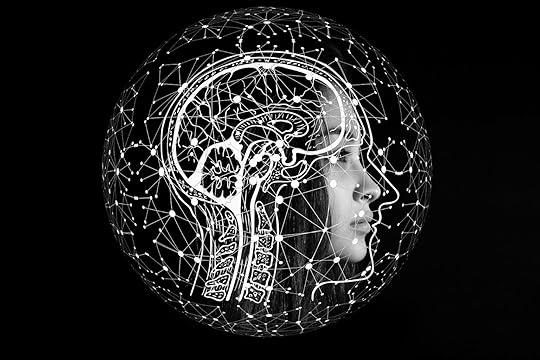
Take Hermann Ebbinghaus’s forgetting curve. His research observed that most people forget newly acquired information within the span of a few hours. And even those with stronger memories kept those facts for at most a few days.
It’s possible to overcome the forgetting curve, but it takes hard work and reinforcing what you learn at regular intervals.
Chances are, current events and popular culture tidbits aren’t the kind of thing you spend time trying to memorize. So it stands to reason, most of those memories aren’t retained.
Compounding the issue is the fallibility of memory in general.
False Memory Syndrome and Pattern Recognition
False memories occur when a person recalls something that did not happen or happened differently than they recall. Sound familiar?
Sigmund Freud and Pierre Janet initially investigated this psychological phenomenon.
Since that time, suggestibility, the incorporation of misinformation, associated information, and source misattribution have been suggested as mechanisms to explain false memory syndrome. Episodic memory might also play a role.
The unreliability of eyewitness reports has long been known. Simply changing an article in a question (for example, “the” vs “a” referring to an object in question) can change the answer a witness gives about what they saw.
Priming – or factors that happen before an event – can affect a person’s recall. Information learned after the fact can also skew what an eyewitness remembers.
The brain likes to encode similar memories into categories so it can make sense of the world. And humans naturally tend to look for patterns. Chunking allows the brain to store information in easy-to-remember packets.
Incorrect recall can also be caused by effort after meaning. This is the brain’s persistent effort to put unfamiliar details into context and transform information to make it more understandable. Also responsible for memory errors – especially with age – is confabulation, where your brain fills gaps to make more sense of what it sees and hears.

Elderly woman sleeping with string on her finger
And even people with aphantasia (who don’t have the capacity to form mental images) usually still have the capacity to recall memories. The memory is just a conceptual list of things that occurred, rather than a video playing in their head.
But does the written word make a difference in how we remember things?
The Oddity of Reading
The brain is quite skilled at making sense out of randomness.
Take, for example, our ability to raed ltteers and wrods taht are in teh worng oredr. Randomizing letters in the middle of words has “little or no effect on the ability of skilled readers to understand the text.” However, it does result in slower reading speeds for most people.

Coming back to the Mandela Effect examples above, let’s look at how Froot Loops also fits the brain’s desire for spelling “sense.”
“Berenstain” is a weird word that can’t be correct due to the incongruity between children’s literature and what “stain” means. The mind probably corrects it to fit the appropriate picture. In similar fashion, Froot Loops shares in this “make it fit” correction.
Every time I think of the Berenstain Bears, the comedy film The Bad News Bears comes to mind. But because there is no spelling incongruity, there is less likelihood of The Bad News Bears becoming a Mandela Effect trend.
Leaving behind the individual human brain for a moment, let’s explore the collective human brain: the internet.
Your Brain, Online
The Mandela Effect was not documented until the Internet Age.
And I would be remiss if this post didn’t cover the role the internet plays in this discussion. Never before in human history has information flowed so freely, and been shared so widely.
Misconceptions and falsehoods easily gain traction because of their entertainment value. Then they are quickly and easily shared via the seemingly endless online platforms connecting the human race.
In a world where tweets about earthquakes move faster than the earthquake itself, false information spreads just as quickly. And with each repetition, the frequently repeated errors become part of our collective reality.

So with the cards stacked against us – and our memories letting us down – how can we tell what memories are true, and what’s a figment of our imaginations?
It’s time to bust out the debunking tools.
Why Critical Thinking is Key
In a world of false memories, human error, internet untruths, presumptive baloney, and high emotions, you need a way to figure out what is truthful and factual.
While there are several different definitions of critical thinking, for the purposes of this post we’ll keep it simple. Critical thinking involves analyzing facts to come to a well-thought-out conclusion.
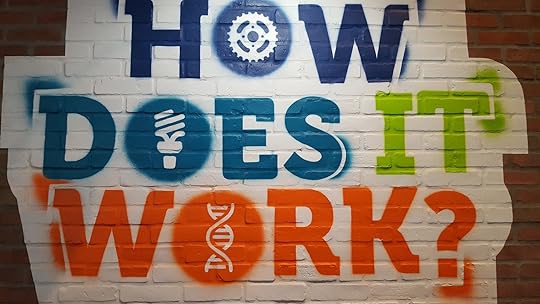
In the words of Carl Sagan, we can use critical thinking as our own personal “Baloney Detection Kit.”
In science, every experiment begins with facts. These might be results, data, observations, measurements… which are then put to the test.
Michael Shermer drew on Sagan’s work, and created a newer version of the kit. Here are his 10 Baloney Detection Questions:
How reliable is the source of the claim?
Does the source often make similar claims?
Have the claims been verified by someone else?
Does this fit with the way the world works?
Has anyone tried to disprove this claim?
Where does the preponderance of evidence point?
Are the people making the claim playing by the rules of science?
Are they providing positive evidence?
Does the new theory account for as many phenomena as the old theory?
Are personal beliefs / ideologies driving the claim?
By asking these questions, you can determine if:
The data is cherry-picked to support a particular belief,
The source has an open mind (but “not so open their brains fall out”),
The experiment is repeatable with the same results,
There are supporting materials,
Most of the evidence leans in one direction,
There is evidence in favor of the theory (rather than negative evidence),
The new theory explains all the things the old theory explained,
There is confirmation bias,
And you’re not just being tricked by something like the flashbulb memory phenomenon.
So, by putting the Mandela Effect to the Baloney Detection test, you can determine that none of the prevailing theories hold water.
Given the facts, and faced with a faulty memory, is there anything else you can do to strengthen your Baloney Detector?
The Power of Positive Skepticism
Keeping a skeptical outlook can help you fine tune your ability to distinguish between fact and fiction.
But did you know skepticism can also help your memory?

You may be skeptical of this claim… but it’s true. Here are a few reasons why.
Skeptics tend to follow the laws of a universal rule.
They believe the responsibility for demonstrating the validity of a claim falls on the person making the claim.
Skeptics are often quite determined.
They badly want to get at the truth. So they’re able to tackle memory training with a heck of a lot of diligence.
Skeptics end up creating multiple levels of energy.
They begin, determined their memories can’t be improved. And when they start to realize they’re wrong, a new type of energy takes its place — the energy of excitement about their “surprising” results.
This happens because they go out and investigate. They use their Baloney Detector… and find out they were feeding themselves baloney. Namely, that they couldn’t improve their memories.
Are you skeptical yet?
Mandela Effect: Trick or Truth?
So what about you? Are you convinced that the more out-there explanations of the Mandela Effect are, in fact, baloney?
October 28, 2019
2019 Canadian Memory Champion Reveals His Memory Secrets
 Want to become a memory champion?
Want to become a memory champion?
Great!
Competition can encourage you to function at your absolute highest level.
Even if…
You’re retired.
To help you understand exactly why and how anyone can learn so much from joining a memory competition, today’s guest is James Gerwing.
Or Jim, as he signed off when he wrote to tell me:
Anthony, Jim Gerwing, here. About 5 years ago, I began taking your online course and then went into some memory competitions. I am the 4 time, current, undefeated (and record holder) of the Alberta memory championships.
Even better: I just won the 2019 Canadian Memory Championships (AND the first ever pan-provincial championship). Thanks for your input.
As you’re about to learn, I had no solid idea just what he meant by “input”!
But I wasn’t entirely clueless either…
As you can see from my State of Your Memory Address from 2016, he’d already broken a few memory competition records back then.

You just have to love what emerges from consistent practice and exploration of these powerful techniques!
And that’s why I just had to get James on the show to talk about how exactly the Magnetic Memory Method served along the way.
About Memory Champion James Gerwing
James is the 2019 Canadian Memory Champion.
He’s also the winner of the 2019 and 2017 Alberta Memory Championships, and earned the bronze medal at the 2018 Canadian Memory Championships in Toronto.
He’s obviously a memory expert too, and has even created his own “Mind Sharp” course.

In this Magnetic Memory Method Podcast interview, James shares his personal journey of memory improvement, and eventually, entry into the world of memory competitions.
Now retired from an impressive career as an educator, James plans to continue competing. I’m confident he will continue to win!
Do You Have To Become A Memory Champion To Learn These Techniques?
No, but some experience with competition helps.
For example, my own memory skills accelerated in unexpected ways after I sat to compete for charity with Dave Farrow.
Obviously, competition isn’t for everyone, but as Simon Luisi has written on the Canadian Memory Championships site:
“One of the best ways [to improve memory] is to participate in a memory competition.”
Whatever side of the fence you stand regarding competition, I encourage you to take a few minutes and listen to James’ perspective.
You just might reconsider where your opinion falls. I know I had and it handed me more knowledge than I ever could have expected!
Just press play above and you’ll discover:
How a love of memory can be ignited at a young age, and memory techniques are vital to the education system
The reason competition performance differs from private practice in memory work
Why stress can be beneficial to memory improvement
The rationale of why memory techniques are not utilized in everyday life…and why they should be
How a memory champion really prepares for competition
A practical example of the use of the Major Method, and a welcome hack for “odd numbers out”
A proven way to relate cards, numbers, Magnetic Stations, and a PAO list
Why Memory Palace journeys don’t always have to be linear
When your memory associations are better off left unsaid
The reason memory competitions aren’t actually an external competition, but a solo performance
Plus much, much more, because…
… a second part to this interview is exclusive to the Magnetic Memory Method Masterclass. It’s already available in the card course James used to learn the skills that helped him win!
Further Resources on the Web, this podcast, and the MMM Blog:
James’s interview the Edmonton Prime Times
Major System Secrets And The Future Of Your Memory With Florian Dellé (referenced in this interview)
Next Level Memory Training Secrets with USA Memory Champ John Graham (referenced in this interview)
Katie Kermode On Memory Competition and Casual, Everyday Mnemonics
Nelson Dellis on Remember It! And Visual Memory Techniques
Idriz Zogaj On The Truth About Memory Training Apps
Memory Improvement Fun And Games: Mark Channon Talks About How To Remember Anything
Do you want to join in the competition? Check out Art of Memory’s current memory competitions list
And if you need help, learn how to create an UNSHAKEABLE Memory Palace Training Routine, so you stand a chance of winning too. Both in learning, competition and life overall.
The post 2019 Canadian Memory Champion Reveals His Memory Secrets appeared first on Magnetic Memory Method - How to Memorize With A Memory Palace.
October 17, 2019
Iconic Memory Defined And Why Photographic Memory DOES NOT Exist
 She disappeared in a flash, but when I closed my eyes, I could see her beautiful face looking pleadingly in my direction.
She disappeared in a flash, but when I closed my eyes, I could see her beautiful face looking pleadingly in my direction.
Reads like romantic fiction, doesn’t it?
It’s actually your iconic memory recalling a visual stimulus in its technicolor glory.
In this post, you’ll learn all about iconic memory, why it’s important and how to improve it to enable better memory and recall. I’ll also break a few myths about picture-perfect memories.
Here’s what I’ll cover in this post:
What Is An Iconic Memory?
Why Iconic Memory is Not The Same as a Photographic Memory
How is Iconic Memory formed?
George Sperling & Other Experiments
How Does Iconic Memory Move to Long-Term Memory?
What Function Does Iconic Memory Serve?
How Can You strengthen your Iconic Memory?
What Is An Iconic Memory?
Iconic memory is one type of sensory memory.
It is a short-term visual memory and lasts only a few seconds before getting discarded.
Your brain uses iconic memory to remember (for a brief time) an image you have seen around you.
Your sensory memory stores all information that you experience through your five major senses – touch, taste, sight, hearing, and smell. Check out these sensory memory exercises for a wild, mental adventure.
Such storage of all stimuli is an automatic response by your brain. If sufficient attention is given to this stimulus, the information may then pass into your short-term memory, and from there, it can get encoded into your long-term memory.
However, in most cases, sensory information is thrown out within a few seconds.

This Puts The “Icon” In Iconic
When some kind of sensory input enters your visual system, it goes into your iconic memory. The visual system includes the iconic memory, visual short-term memory and long-term memory.
Iconic memory is simply your brain’s way of processing visual information. The brain sees this information as distinct flashes or ‘icons,’ hence the name iconic.
For instance, imagine you are driving through the countryside and a lovely cottage with a red front door flashes past. You continue to drive, but can still see the “image” in your mind’s eye.
This after-image of the cottage in your mind’s eye even after it ceases to exist in your visual plain is the working of your iconic memory.
Here are some other examples of iconic memory:
Your friend is reading a book, and you ask her which books is it. Your friend shows you the cover of the book for just a brief moment before hiding it, leaving you with only the impression, or iconic memory, of what the book’s cover looked like.
You come home one evening and as you turn on the living room light the bulb burns out, leaving you in darkness. But your mind’s eye can still visualize (albeit briefly) what the room looked like in the luminance of the bulb.
In other words, your brain takes a snapshot of every image it “sees” and stores that as an after-image only for a few seconds in your iconic memory. Apparently, this happens in your brain, even if you have aphantasia.
The question is… how is it like a camera taking a picture?
Is it the same as a photographic memory?
Iconic Memory is Not The Same as a Photographic Memory
Let’s get one thing clear.
Photographic memory does not exist.
The phenomenon where you have instantaneous recall of any and all events by uniting your visual, spatial, audio, and verbal memories is not possible by humans.
You may have heard that Teddy Roosevelt could repeat aloud entire newspaper pages as if he was reading from it, or of artists like Arturo Toscanini, who was able to conduct the opera from memory after his eyesight became too poor to read the music.

Many world champions and memory experts like Nelson Dellis can memorize and recall many digits of Pi, but there is no verified case which shows memory working like a camera with total and complete recall.
But what if you can remember your experience in great detail – right down to the color of the car that you took to go to Disneyland when you were five years old? Does that mean you have a photographic memory?
Simple answer: No.
What you can have is an eidetic memory – a memory that is very vivid and has great potential for recall.
However, to clarify – eidetic memory is not photographic memory. It simply means you can remember many things in great detail, but not all the details.
More importantly, eidetikers may even invent details that were never there.
Quick side note:
Some researchers found that a mutated fruit fly could potentially possess a form of photographic memory.
Over the course of their brief lives, a fruit fly with a boosted CREB gene could have a form of photographic memory. While humans also share DNA with fruit flies, the potential for a similar boost in humans is yet to be researched.
So, if iconic memory isn’t photographic, why do we even need it?
It seems unimportant, right?
Maybe not. You’ll know in a minute.
Let’s first understand how iconic memories are made.

How Is Iconic Memory Formed?
The occipital lobe is the central part of the brain involved in iconic memory. This lobe is responsible for processing and regulating visual information.
When you “see” something, the visual information is received by the photoreceptor cells in the eyes and sent to the occipital lobe. Here it is stored for a few milliseconds before being it is forgotten or transferred to the temporal lobe.
This visual memory or visual persistence is then converted from visual short-term memory to long-term memory by the hippocampus, which is located inside the temporal lobe.
There may be psychological visual persistence of a visual stimulus for some time after its physical offset. There are three senses where it can persist.
The Three Persistences
The first is neural persistence which occurs when neural activity continues after the stimuli are gone.
The second is visible persistence – when you continue to see an image even though it is gone, such as with a flash of bright light.
The third is informational persistence – when an observer continues to retain information about a visual stimulus for some time after the stimulus is gone.
Research into these three stages of visual persistence was done by Max Coltheart.
In 1980, Max Coltheart performed research into the three stages of visual persistence.
His study also suggests that any physical stimulus must be temporarily attached to a representation in semantic memory. However, episodic memory is not involved in this process. This temporary storage of information is what constitutes iconic memory.
Iconic memory capacity is also extremely brief. Usually, the duration of iconic memory is less than one second, and this duration is fixed irrespective of how long visual stimulus is displayed.
Iconic vs Echoic Memory
The iconic memory and echoic (auditory) memory are the two most extensively studied sensory memories.
The other main types of sensory memory include touch or haptic memory, taste or gustatory memory, and smell or olfactory memory.

One big difference between iconic memory and echoic memory is regarding the duration and capacity.
While echoic memory lasts up to 3-4 seconds, iconic memory or short-term visual memory lasts only up to one second. However, while iconic memory can preserve 8-9 items, the capacity of the echoic memory is 4-5 items.
George Sperling & Other Experiments With Iconic Memory
American cognitive psychologist George Sperling documented the existence of iconic memory.
Cognitive psychology is the study of mental processes such as memory, perception, problem-solving, attention, language use, etc.
Through several experiments, Sperling showed that humans store a perfect image of the visual world for a brief moment – as icons – before it is discarded from memory.
However, it was psychologist Ulric Neisser who in 1967 labeled this form of quickly fading visual memory as iconic memory.
Sperling’s initial experiment used a matrix with three rows of three letters. The participants were asked to look at a visual display of letters, for a short period, and then recall them immediately. Under this technique, subjects were able to, on average, recall 4-5 letters of the 9 they were given.
The results helped Sperling conclude that our short-term visual memory can hold the information even if it is exposed to it for a few seconds.
He reasoned that the reason the subjects were not able to recall all of the letters was that this memory disappeared in less than a second.
Sperling didn’t stop there. Next, he tried a variation to this experiment, known as the partial report method.
In this partial report method, after the visual display of letters, Sperling sounded a high, medium, or low tone. The tone was a cue for the participants. Depending on which tone was sounded, the participant read the high, medium, or low row of letters.
This time around, when the participants had a cue they were able to recall more letters. The partial-report experiments determined that even though we see all the visual image of letters, we cannot recall them all because the memory is fleeting.
While Sperling’s experiments with memory tasks mainly tested the information related to a stimulus, others such as Coltheart performed directs tests of visual persistence.
Coltheart also questioned the relation between visual persistence and iconic memory.
In his report, Iconic memory and visible persistence. Perception and Psychophysics, (27, 183-228), Coltheart says “Iconic memory and visible persistence are often treated as the same. However, whether these two phenomenon are the same is an empirical question.
“The earlier review established that two properties of visible persistence are 1) an inverse relationship with stimulus duration and 2) an inverse relationship with stimulus luminance, or intensity. Iconic memory must exhibit these two properties before it can be equated with visible persistence.
“There is no evidence that the duration of iconic memory and luminance are inversely related. Furthermore, although there is some evidence that increasing stimulus duration has an effect on iconic memory persistence, this effect is direct rather than inverse. Thus, visible persistence—which is very sensitive to physical display features—and iconic memory seem to behave differently.”
Nearly two decades after Sperling’s original experiments, visual persistence and informational persistence emerged as two distinct components of visual sensory memory.
How Does Iconic Memory Move to Long-Term Memory?
A lot of focused attention is needed to move information from iconic memory to durable storage – which is your short-term memory and subsequently, your long-term memory.
The human memory system works on encoding, storage, and retrieval of information. In 1968, Atkinson and Shiffrin suggested this model for human memory. It includes three components – sensory memory, short-term memory, and long-term memory.

The Human Memory System Simplified
Here’s a simplistic explanation on how your memory system works:
In the first stage, any incoming sensory or perceptual information is held in the sensory memory. The information gathered through the senses is an exact copy of what you perceive. This information is stored in your sensory memory for a very short duration.
For instance, as soon as you get a visual stimulus – you see an apple – it is processed by your eyes and moved into the occipital lobe. Next, recognition occurs, and this information is then placed into iconic memory. All this takes place very quickly.
From the iconic memory, only a limited amount of information that you consciously pay attention to moves into the visual working memory – this is your short-term memory for visual stimuli. Everything else is discarded.
This short-term memory does not have unlimited capacity. It can only store a limited amount of information.
Conscious perception makes a significant difference in the memory process.
The information can remain in the working memory for several minutes before being discarded or stored in long term memory.
Over time, memories get etched in long-term storage. For this, you need rehearsal and petition to practice your recall of information which enables you to move information from short-term to long-term memory.
What Function Does Iconic Memory Serve?
If iconic memory lasts only for a few microseconds, is it at all important?
Absolutely!
The role of iconic memory in creating new memory is significant.
This form of sensory memory provides a steady stream of visual information to the brain, which can then be processed by your short-term memory into more stable and long-term forms of memory.
Scientists are also using iconic memory to make revolutionary discoveries. One of them is the role of this memory in change blindness or our inability to detect significant changes in our visual field.
In certain experiments, they discovered that we tend to have trouble with change detection from one scene to another if we face brief intervals between them.
According to researchers, that happens because that delay or interruption wipes out the iconic memory of the scene, which makes detecting differences all the more difficult if not downright impossible.
Iconic memory loss has also been linked to the onset of Alzheimer’s disease, so it may be prudent to strengthen this type of sensory perception.

How Can You Strengthen your Iconic Memory?
Since iconic memory is one type of sensory memory, improving your overall sensory perceptions will result in better retention of visual information.
Attention also plays a vital role in not only transferring information from iconic to working memory but also when the iconic memory is formed.
According to this study, the formation of iconic memory is disrupted when attention is diverted even if that happens for a brief period of time.
The human mind is capable of faultless information processing, just like a computer. It takes in information, organizes and stores it to be retrieved at a later time.
However, for this information processing to be accurate, you need to be aware and deliberate in your learning.
Be Intentional To Have Better Memory
When you are intentional, you perceive things better.
Why is that?
Because you are paying attention to everything around you – all your senses are sharper and focused on absorbing the information around you.
Greater attention means better perception, which results in good memory.
Memory exercises can be used to strengthen your attention which in turn will improve retention and recall.
However, your memory improvement training should always be linked to memorizing information that will immediately improve your life. It should always be measurable since tracking your outcomes leads to rapid improvement.
This is where creating Memory Palaces using the Magnetic Memory Method can come in handy.
It enables you to unlock the power of all types of memory – autobiographical, sensory, episodic, semantic, procedural and more so that you can move information into long term memory faster and with predictable and reliable permanence.
Keen to unlock your natural ability to learn and remember anything fast?
Why not try the Magnetic Memory Method today?
The post Iconic Memory Defined And Why Photographic Memory DOES NOT Exist appeared first on Magnetic Memory Method - How to Memorize With A Memory Palace.
October 10, 2019
Memory Palace Software: Matthew Snow on Using MemoryFiler
 Ever heard the phrase “Work smarter, not harder”?
Ever heard the phrase “Work smarter, not harder”?
Well, what if there was a way to translate this idea into your memory improvement efforts?
Sure, there are a lot of apps and learning systems that promise big results.
In reality, most fall flat as tools and memory aids. But there is something potentially revolutionary in the memory software world that I want you, the Magnetic Memory Method Community, to know about.
Today’s guest, Matthew Snow is the creator of the app, MemoryFiler.
A former Army serviceman, Matthew initially became interested in memory techniques as a way to better himself personally.
Using mnemonics eventually grew to Matthew’s desire to help others attain their memorization goals through using his fascinating Memory Palace Software. Here’s a demo:
Matthew’s Memory Palace Software is highly personal, and isn’t a hack or a shortcut.
Far from it:
You’re still putting in the work, but it actually aids you in remembering your Magnetic Imagery. You do the encoding, and you make the associations. However, with this memory software, your images are at-the-ready for Recall Rehearsal as you work on committing them to memory to use in your work.
The Difference Between This Memory Palace Software And The Rest
That’s the difference between MemoryFiler and the flooded market. It takes your best efforts, your commitment, your encoding, and your imagery, and gives you a little boost, so that you can work smarter, not harder.
So if you’re looking for a way to maximize your imagery, and if you’re searching for a more high tech way to record that imagery instead of putting pen to paper – if flashcards simply aren’t a tool in your personal toolbox, listen up.
Simply press play using the audioplayer at the top of this page to discover:
How Matthew’s military experience was helped by the Memory Palace technique, and what servicemen and women really need to know for a promotion
The secret to getting “unstuck” with visual imagery used in memory techniques
What traits are necessary for success in entrepreneurship (and how consistency and routine relates to memory training routines)
Strengths and weakness of kinesthetic and visual learning styles
The benefit to reducing cognitive load through the use of apps, and why you shouldn’t “beat yourself up” over using them
Why social media is really asocial media, and why this is a metaphor for other “memory games” on the market
The need for analog and digital to work in tandem, and why we can’t “throw the baby out with the bathwater” when it comes to choosing one over the other
The reality of the generational gap between Generation X and Generation Z, and the influence the digital age has had on these groups
An explanation of dual-path readership and its development in modern culture
Why you should be concerned with media sovereignty
The real way to improve focus and concentration
The reason pop culture junk may be more useful than you think for memory work (Hint: It has to do with semantic memory)
Warning signs and indicators you’re dealing with the “pain of disconnect”
Further Resources on the Web, this podcast, and the MMM Blog:
How To Find Mnemonic Imagery ANYWHERE (MMM Blog)
3 POWERFUL Elaborative Encoding Memory Exercises (MMM Blog)
4 Powerful Ways to Use the Pegword Method [10 Examples Included] (MMM Blog)
3 Blazing Fast Ways To Increase Memory Retention (MMM Blog)
The post Memory Palace Software: Matthew Snow on Using MemoryFiler appeared first on Magnetic Memory Method - How to Memorize With A Memory Palace.
October 1, 2019
Martin Faulks On The Memory Palace In The Masonic Tradition
 Have you ever thought about how improving your memory can improve your life? Not just surface level, daily routine improvements, but really transform who you are as a person?
Have you ever thought about how improving your memory can improve your life? Not just surface level, daily routine improvements, but really transform who you are as a person?
Did you even realize that memory training makes personal improvement possible?
Or do you limit memory improvement in your mind as merely a tool for remembering dentist appointments and names?
Well, here’s great news:
The art of memory goes far beyond showing up on time and not having to look down at name tags and desk plaques.
With practice, thorough memory training based on a scientifically sound application of the Memory Palace technique will radically transform you.
Not just your outward life and the things you do from day to day.
It will expand the limited notion of what you think your “self” to be.
This outcome isn’t just what the ancient gurus promised, but also the same kind of results respected neuroscientists like Sam Harris are actively promoting in our time.
How is this possible, you ask?
My guest today is memory expert Martin Faulks. He’s also an expert in the field of meditation.
Complimenting his mediation and memory training experiences, Martin’s a martial artist, yoga teacher, and author of over half a dozen books on subjects such as enlightened living and tai chi. His newest book, A Mosaic Palace: Freemasonry and the Art of Memory explores the link between the ancient tradition of memory techniques and the secretive fraternal organization, the Freemasons.
But Martin also takes on fun and unique memory challenges. For example, check out this interested memory demonstration:
You really can incorporate fun activities with personal self-development.
To that end, Martin and I explore memory as an internal transformative art that can change the very core of our being. Martin argues that while in antiquity inner transformation through memory was a common practice, too much of this tradition it has been lost in our modern age. The secret then to restoring this idea lies in your approach to committing to the techniques themselves with carefully chosen goals.
The best part?
It’s possible to have that transformation with a bit of guidance because the keys are already within you. What you seek is attainable, and it is within your means to take control of your own life.
Whether you suffer from anxiety, unhealthy coping mechanisms, constantly feel a sense of failure when it comes to interpersonal relationships, or you find yourself sabotaging your own success you can benefit from the advice Martin so freely gives in our conversation.
All you have to do is click play to learn about:
Memory training and the potential for learning leading to inner transformation (and how what you put into your consciousness can change who you are).
How the Renaissance caused the art of memory to become a path of cultivation of virtue instead of simply utilitarian
How Memory Palaces are useful as a form of meditation
The impact of adaptive strategies on our personality and coping and life skills
The hidden ways your mind is trying to help you
The method in which you learn something affects how easy it is for you to reference it
Why the church banned texts like the Ars Notoria as a “sorcery version of memory”
How the memory method of corporeal similitudes is the most powerful way to create associations for memory
The debate about whether Sherlock Holmes is a figure to look up to (otherwise known as a hero of an extra level of functioning) to when it comes to memory goals
Comparing and contrasting memory and sorcery, and memory palaces and magic circles
Why Giordano Bruno was a memory master and “terrible” teacher
The differences in the definition of a memory master according to various cultures
After listening to this interview, you might be wondering…
Should You Read A Mosaic Palace By Martin Faulks?

In my view, absolutely.
Anyone serious about the memory improvement tradition owes it to themselves to read as much about mnemonics as they can.
It’s not just about you, as you’ll discover today. It’s about everyone’s role in preserving knowledge for the good of the whole.
The number of ideas you discover when you focus on continuous study will impact your practice.
A Mosaic Palace provides historical insight and diagrams that you can translate into powerful Memory Palace training exercises.
For example, Martin’s book inspired me to rethink some of my previously held notions about how the method of loci was used in the past.
Few memory books combine history, philosophy and technique directed at self-realization. In a world cluttered by competition-based books, A Mosaic Palace is a breath of fresh air.
Plus, Martin has more exciting contributions coming. I also can’t wait to read The Hermetic Art of Memory by Alexander Dicsone.
The adventure never ends!
Further Resources on the Web, this podcast, and the MMM Blog:
Scott Gosnell Talks about Giordano Bruno (MMM Blog)
How to Memorize Like Sherlock Holmes with a Mind Palace (MMM Blog)
How to Train Your Memory By Phil Chambers (Book review)
Memory Craft (Discussion with Lynne Kelly)
The post Martin Faulks On The Memory Palace In The Masonic Tradition appeared first on Magnetic Memory Method - How to Memorize With A Memory Palace.
September 25, 2019
3 Kinds of Neurobics for BETTER Memory Boosts And Brain Exercise
 Have you done any cross fit training or heavy lifting with your brain lately? If not, you need neurobics.
Have you done any cross fit training or heavy lifting with your brain lately? If not, you need neurobics.
Why?
Well, for one thing, this special form of mental exercise makes your ability to focus and concentrate a lot sharper.
On this page, I’ll show you what they are and how this special form of brain fitness can help your mental life thrive.
I’ve broken the kinds of neurobics into 3 categories and will share 15 kinds of exercises you can try.
Make sure to bookmark this page and come back to it often each time you want more ideas for getting the benefits of this most powerful form of brain fitness.
Neurobics Defined:
Memory Boosting Routines That Pack Small And Play Big
Neurobics are activities, or mental (cognitive) exercises that stimulate the brain, prevent memory loss, and improve memory recall.
Just as physical exercise stimulates the muscles, so the muscle of the brain is stimulated with neurobic exercise. We all are familiar with the benefits of aerobic exercise to the heart and the lungs, but we often overlook the benefits of neurobics to strengthening of neurons and neuronal networks. The association here is so simple, and yet so often ignored.
In sum, neurobics comprehensively stimulate different areas of the brain.
Why A Fit Brain Is The Best Way To Preserve Memory
Neurobics, when practiced consistently, have the power to prevent memory loss.
How?
Memory loss comes from atrophy of the brain. In the same way that bone density goes down and muscles shrink with no training, so the brain can become deteriorated with no stimulation. This is why neurobics are so important, not only for your memory goals now, but in the future, years to come.
Neurobics can also potentially improve memory recall.
That means regular mental fitness is the best line of defense and the best compliment to a memory training system.
While neurobics will not improve your memory in the same way as a laser-targeted, focused memory improvement practice, the element of discipline neurobics can bring are a perfect companion to tools like Memory Palace training techniques.
From Better Mood To Laser Sharp Focus:
Brain Benefits On Tap
Besides the benefits to your brain and memory, incorporating neurobic exercise into your life can improve your mood, focus, memory, and mindset.
Do you want to be in a better mood?
We all do, don’t we?
In fact, no one wants to dredge through their day, dreading the next one to come when their head hits the pillow at night. That’s no way to live, if you can even call that living.
Brain stimulation through neurobics creates blood flow. Because feelings and physiology are inextricably linked this circulatory response that accompanies neurobic exercise can trigger feelings of joy.
Neurobic exercises are based on the idea of focus, making a conscious effort to perform tasks that have been, essentially, automated by our brains. With this “focus on focus” with simple activities we can, therefore, improve that focus.
The Link Between Neurobics and Memory Exercise
Neurobics also have the potential to improve your overall memory.
By performing the exercises I want to share with you on this page, your memory will be strengthened. By simply making the conscious effort in, essentially, mundane tasks, your brain is engaged and primed for incorporating more formal memory training exercises.
Finally, neurobics can help with one of the greatest struggles in modern-day society: negative self-talk.
We have all been guilty of weaponizing our own thoughts against ourselves.
We have no energy because we are constantly beating ourselves down, but neurobics can help you escape from the negative framework that has you trapped. A shift in focus, from belittling yourself for no good reason, to congratulating yourself for a job well done is possible, all with some unassuming, but powerful, exercises.
And let’s face it:
When you feel better, you have a better mindset. It’s just that simple.
The 3 Major Categories Of Effective Neurobic Exercise
Neurobics often include some kind of physical component, an environmental component, and auditory component. You will interact with the world, creating neuroplasticity in your mind, with these three major categories of neurobic exercise:

Category One: Physical Neurobic Exercise
Our brains are tailored towards efficiency, which is beneficial when we encounter a problem or new activity. We automatically problem solve, which is amazing, but these “same old, same old” routines do nothing for mental development.
1.Non-dominant hand exercises with writing
One of the most obvious examples of this shortcut in our brains is the concept of a dominant hand. Which hand do you unconsciously pick up a fork with? How about waving to a friend across a crowded room? The hand that you use for daily activities without even so much of a thought is considered to be your dominant hand.
In neurobics the most beneficial physical neurobic exercise is non-dominant hand development.
Just switch up your daily activities and use your “opposite” hand. This will bring a mindfulness and pause so that you must actually stop and think about the activity you are engaged in.
Start small with brushing your teeth with the opposite hand. This is just a small, almost minuscule change that can bring a different sensation to an obligatory, automatic morning routine.
For more of a challenge try to write with your non-dominant hand. I discovered I was a bit ambidextrous in this sense. Working as a professor it would bring me joy to, instead of physically moving to a new spot on the blackboard, to simply switch hands.
You can incorporate this technique into your memory journal as well. Try to do your gratitude journaling and general personal development goal-setting with your non-dominant hand, or try writing from right to left, instead of left to right.
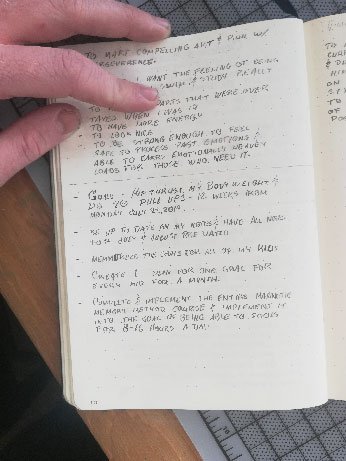
Don’t worry if it’s sloppy at first. With practice your penmanship will improve. Instead, really focus on the goal of giving different parts of your brain different exercise.
Plus, you can apply this kind of journaling to language learning as well.
This minor change can have major impact. You are increasing your focus on the content. Form and content will come together, and your focused attention makes you pay greater attention to what you’re doing, which gives it more meaning, more impact, and because you’re activating more of your brain, this makes your thoughts much more likely to be translated into action.
2. Non-dominant hand music exercises
If you are a musician, make changes in your playing. If you are a bass player and tend to play the higher tones with your left hand, try switching hands. At first you may want to simply cross your body, before moving onto something more complex. From here you can build your skills to eventually playing left-handed if you normally play right-handed with 10 to 15 minutes of consistent, daily practice.
3. Playing card non-dominant exercises
If music’s not your bag, perhaps cardistry or legerdemain. I practice both myself:
Everyone loves a good card trick that leaves the crowd wondering “Now how did he do that?”
To this end, I’ve trained myself to do magic tricks with my non-dominant hand and shuffles with my non-dominant hand. In standard practice think of mirrored tricks that take both hands to operate equally. You can build your skillset for dual handed tricks by using your non-dominant hand.
5. Neurobic exercises with your mouth
You can also use your tongue in neurobic exercise. Because “the tongue and lips are among the most sensitive parts of the body, even more sensitive than the fingertips,” the benefits to using these muscles in neurobics is paramount.
6. Ear Pinch Squats
Finally, try ear pinch squats. I know it sounds wild, but you are incorporating movement and function in several muscle groups, and we know this has palpable benefits.
Think back to the idea of cross training. Try crossing your arms, pinching your ears, then go into a squat. You can build this practice by upping your squat reps, or holding the squat longer, like a chair pose in yoga.

Category Two: Environmental Neurobic Exercise
Move beyond your personal motor skills and take your practice to the world around you.
7. Eyes closed navigation exercise
Take a familiar, unobstructed area, and walk through it to a destination of your own choosing with your eyes closed. If you are in an apartment, step off the elevator, or out of the stairwell and walk down the hallway with your eyes closed.
8. The key exercise
You can increase the challenge with the eyes closed key exercise.
Everything, from getting out of the elevator, walking to your front door, getting out your keys, identifying the key that’s needed, putting the key into the keyhole, turning the key to unlock the door, opening the door, stepping inside, and closing the door, can, with, practice, be done with your eyes closed.
You’ll find your spatial recognition and your other senses will be in a heightened sense of awareness, all by removing sight from the equation.
9. Eyes closed showering
When you’re in the shower you are creating a diffuse in mental environment, really, without realizing it. This is why a lot of creative ideas come in the shower, due to your mind wandering.
Maximize your focus and concentration by letting this natural mind wandering occur while showering at the best possible time of day, mornings. You can even try cold showering, breathing, chanting, and Wim Hof techniques in tandem with eyes closed showering for an even greater boost!
10. Eyes closed eating
Another exercise that is easy to incorporate multiple times a day is eyes closed eating. You will experience a different tactile sensation, experience, and different sounds.
Food may even taste different, better. We often do not focus on the act of eating itself as we are distracted by our environment.
With eyes closed eating you can appreciate what’s on your plate more by consciously separating the environment from your nourishment, separating outside noise from chewing and the sensations of eating in your body from the sensations of the environment, such as other diners walking past in a restaurant. You will be more in the moment, and therefore appreciate the act of eating more.
11. Take different routes
Finally, try changing your micro routes.
With minor changes en route to your destination you make your journey an experience. You will find, if you take notice, that you walk down the street the exact same way daily. What about just circling a mailbox for no other reason than to change the micro route?
Circle a street sign, clockwise one time and counterclockwise the next. Engage in your travel by injecting a bit of play into your routine. If you rely on public transit and are looking to expand this idea of course change, leave the house earlier and take a different route, or on Google Maps select the “avoid highways” option in traveling to your destination.

Category Three: Auditory Neurobic Exercise
12. Tracking individual instruments
Instrument tracking incorporates the sense of hearing, or active listening, into neurobics. Try listening to a song, only listening to one particular instrument throughout. Isolate one instrument and follow it through the song, or throughout a favorite album. The next play through follow the rhythm guitar if you were tuned into the bass, or the lead guitar if you were listening for the drums.
13. Reading exercises
Try reading either ultra-slow or ultra-fast out loud. You are incorporating the physical sensation of moving your mouth and tongue, exercising those muscles, but, at the same time, exercises your focus of hearing as you articulate the words audibly. You can even study auctioneers and their techniques for ultra-fast speech as auditory neurobics.
14. Covering the beat
Try setting a metronome to a certain beats per minute and try to “cover” the click with clapping or snapping. Practice with setting the clicks farther apart, then closer, varying the speed as you build your rhythmic skills. This is beneficial not only to musicians, but anyone who wants to improve their auditory and motor focus.
This brain exercise can be hard to imagine, so please check out this video for a demonstration:
15. Breath counting
Finally, count breaths out loud.
This exercise requires no equipment, no outside stimulus, and can be done anywhere. T
ry either breathing, counting, one, breath, two, another breath, three, or audibly counting “one, two, three” as you are breathing.
Focused breathing, concentrating solely on your own breath, can transform not only these small, conscious moments, but your overall life, reducing anxiety, pain, and even muscle tension relief. Make the unconscious a conscious act.

Your Next Steps
Start small with just one of the neurobic exercises and commit to putting it into action. Set a realistic goal for practice, whatever that looks like for you. Maybe “I’m gonna do this neurobic exercise every day for a week,” if that is an attainable, yet challenging goal for you. Whatever it is, commit, with intention.
Then, simply, execute to completion. If you say you will do the exercise for a week, for seven days actually do it.
Then pick another exercise and repeat. Try for a loftier goal, a longer time period of daily practice, or a shorter time period with multiple daily exercises. You know what is a challenge for you and what is right for your life. Find the benefits in changing up your routine and relish them. You’ll find this is the best motivation for continued practice.
To help those serious about ongoing mental fitness, I created the Brain Exercise Bootcamp. It includes 40 special brain exercises designed to do just that: help you continuously enjoy the benefits of regular mental fitness.
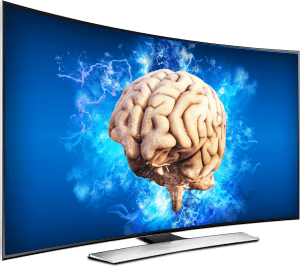
Consistency is important because these exercises changing your brain structure.
That’s what action does. You can’t see the world in a particular way if you’re not taking action. Your perspective can’t change. You can’t shine light into the darkness if you’re not moving.
And, for better or worse, you’ve got to keep moving.
Of course, I know uncertainty about what’s gonna happen can be horrible. But if you do a reality check, and just let go of the need to know what will happen, then you’re going to have much, much better results in life.
This is an important fact because you can’t know anyway. Even if someone could say “This is exactly what’s gonna happen. This is exactly when it’s gonna happen. This is exactly how it’s gonna happen,” it’s not true until it happens to you. And because you cannot know and will not know, what you need to do is you need to just take action anyway, no matter what happens.
Start small and be ready to grow. Just as athletes expands their litheness with cross training, you can take small steps and conscious effort to expand your focus, concentration, and improve your memory, and life. It takes just seconds to take that next step.
The post 3 Kinds of Neurobics for BETTER Memory Boosts And Brain Exercise appeared first on Magnetic Memory Method - How to Memorize With A Memory Palace.




